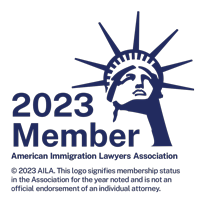May 26, 2006
Yesterday the Senate passed a comprehensive immigration reform bill. The bill does represent progess even though it retains many bad elements. Details of the bill are below, courtesy of AILA. The bill now moves to the joint House-Senate conference to try to resolve the significant differences between S.2611 and H.R.4437.
Path to Legal Status for Undocumented Currently in the United States
- Undocumented in U.S. for at least 5 years prior to April 5, 2006 (estimated 6.7 million) eligible for 6 years of work authorization and path to eventual permanent legal status, upon payment of $2,000 fine, meeting English and civics requirement, passing background checks and paying taxes owed.
- Will get LPR status (“green card”) after current family backlogs are cleared
- After 5 years as LPR, can apply for citizenship.
- Undocumented in U.S. less than 5 but more than 2 years, (estimated 2.8 million) “Deferred Mandatory Departure (DMD) status, providing work authorization and eventual path to permanent status with following requirements:
- Must leave country within 3 years, “touch base” and return
- Can apply for readmission before departure
- Departure requirement waived for spouses/children, or if substantial hardship on person or immediate family.
Family Unity and Family and Employment Visa Backlog Relief
- Those in current family backlogs will get “green cards” before any of the currently undocumented
- New family preference cap of 480,000, adding 260,000 new visas per year to eliminate backlogs
- New employment-based cap of 450,000 for a 10-year period, adding 310,000 new visas per year; spouses and children of certain employment-based immigrants capped at 650,000, others may remain outside the cap
- 30% of employment-based cap reserved for “essential” workers
- Provisions for widows, orphans, and lower threshold for affidavits of support
High-Skilled Immigration Reforms
- Reform of student visa rules to authorize dual intent, expand the period of OPT, and create a direct path to permanent status for certain advanced degree students
- Increase in H-1B cap to 115,000 with market-based escalator and exemption for STEM advanced degree holders
- Exemptions for the annual employment-based cap for STEM advanced degree holders, aliens of extraordinary ability, and outstanding professors and researchers
New Temporary Worker Program with Labor Protections and Path to Permanent Status
- New program for 200,000 new temporary “essential” workers per year
- 3 year visa, renewal for 3 years, with portability to work for employer of choice
- Current undocumented who entered U.S. after January 2004 are eligible, must leave country to apply, 3/10 year bars are waived
- Employer has to seek U.S. worker first; labor protections and market wage requirements
- Can apply for permanent status (“green card”), within the new employment-based cap; can self-petition if worked for 4 years, otherwise employer can petition
Reforms to Agricultural Worker Program
- Farmworkers who show that they performed at least 150 days of agricultural work in the U.S. during the 24 month period ending December 31, 2005 can get temporary resident status (“blue card”); spouse/minor kids get status too
- To earn permanent status (“green card”), farmworkers must perform agricultural work for at least 100 work days per year for 5 years, OR perform 150 days per year for 3 years. Participants may work outside agriculture but only if they are continuing to meet the annual agricultural work requirement.
- The earned legalization program has a cap of 1.5 million.
- The H-2A temporary foreign worker program will allow employers in the dairy industry to hire workers even when they are year-round workers.
Path to Legal Status for Undocumented High School Students (DREAM Act)
- Students who enter U.S. before age of 16 and are present for 5 years preceding date of enactment, and who have graduated from high school (or GED), can apply for 6-year conditional status
- Within 6 years, if graduated from college or completed two years in a degree program, or served in Armed Forces, conditional status becomes permanent status (“green card”)

